2013 CHEVROLET CAPTIVA SPORT tow
[x] Cancel search: towPage 205 of 374
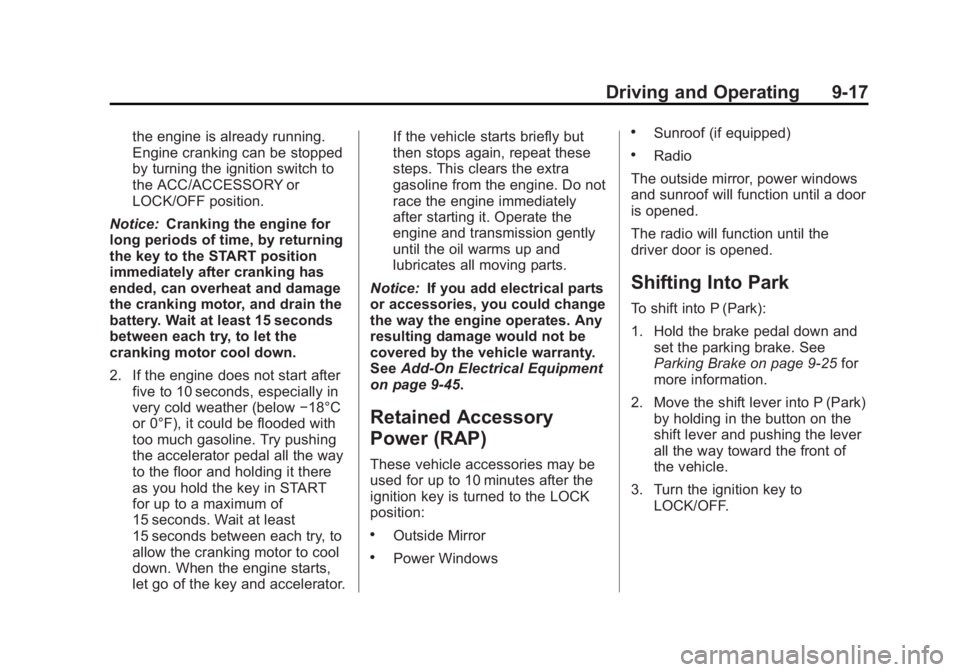
Black plate (17,1)Chevrolet Captiva Sport Owner Manual - 2013 - crc - 11/12/12
Driving and Operating 9-17the engine is already running.
Engine cranking can be stopped
by turning the ignition switch to
the ACC/ACCESSORY or
LOCK/OFF position.
Notice: Cranking the engine for
long periods of time, by returning
the key to the START position
immediately after cranking has
ended, can overheat and damage
the cranking motor, and drain the
battery. Wait at least 15 seconds
between each try, to let the
cranking motor cool down.
2. If the engine does not start after
five to 10 seconds, especially in
very cold weather (below − 18°C
or 0°F), it could be flooded with
too much gasoline. Try pushing
the accelerator pedal all the way
to the floor and holding it there
as you hold the key in START
for up to a maximum of
15 seconds. Wait at least
15 seconds between each try, to
allow the cranking motor to cool
down. When the engine starts,
let go of the key and accelerator. If the vehicle starts briefly but
then stops again, repeat these
steps. This clears the extra
gasoline from the engine. Do not
race the engine immediately
after starting it. Operate the
engine and transmission gently
until the oil warms up and
lubricates all moving parts.
Notice: If you add electrical parts
or accessories, you could change
the way the engine operates. Any
resulting damage would not be
covered by the vehicle warranty.
See Add-On Electrical Equipment
on page 9 ‑ 45 .
Retained Accessory
Power (RAP) These vehicle accessories may be
used for up to 10 minutes after the
ignition key is turned to the LOCK
position: .
Outside Mirror .
Power Windows .
Sunroof (if equipped) .
Radio
The outside mirror, power windows
and sunroof will function until a door
is opened.
The radio will function until the
driver door is opened.
Shifting Into Park To shift into P (Park):
1. Hold the brake pedal down and
set the parking brake. See
Parking Brake on page 9 ‑ 25 for
more information.
2. Move the shift lever into P (Park)
by holding in the button on the
shift lever and pushing the lever
all the way toward the front of
the vehicle.
3. Turn the ignition key to
LOCK/OFF.
Page 206 of 374
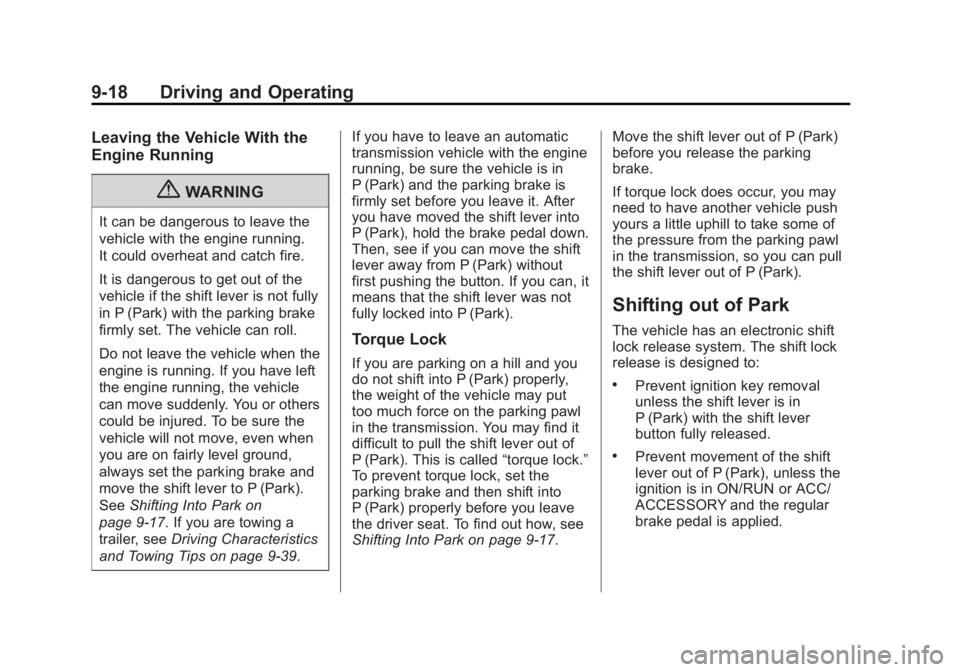
Black plate (18,1)Chevrolet Captiva Sport Owner Manual - 2013 - crc - 11/12/12
9-18 Driving and Operating Leaving the Vehicle With the
Engine Running
{ WARNINGIt can be dangerous to leave the
vehicle with the engine running.
It could overheat and catch fire.
It is dangerous to get out of the
vehicle if the shift lever is not fully
in P (Park) with the parking brake
firmly set. The vehicle can roll.
Do not leave the vehicle when the
engine is running. If you have left
the engine running, the vehicle
can move suddenly. You or others
could be injured. To be sure the
vehicle will not move, even when
you are on fairly level ground,
always set the parking brake and
move the shift lever to P (Park).
See Shifting Into Park on
page 9 ‑ 17 . If you are towing a
trailer, see Driving Characteristics
and Towing Tips on page 9 ‑ 39 . If you have to leave an automatic
transmission vehicle with the engine
running, be sure the vehicle is in
P (Park) and the parking brake is
firmly set before you leave it. After
you have moved the shift lever into
P (Park), hold the brake pedal down.
Then, see if you can move the shift
lever away from P (Park) without
first pushing the button. If you can, it
means that the shift lever was not
fully locked into P (Park).
Torque Lock If you are parking on a hill and you
do not shift into P (Park) properly,
the weight of the vehicle may put
too much force on the parking pawl
in the transmission. You may find it
difficult to pull the shift lever out of
P (Park). This is called “ torque lock. ”
To prevent torque lock, set the
parking brake and then shift into
P (Park) properly before you leave
the driver seat. To find out how, see
Shifting Into Park on page 9 ‑ 17 . Move the shift lever out of P (Park)
before you release the parking
brake.
If torque lock does occur, you may
need to have another vehicle push
yours a little uphill to take some of
the pressure from the parking pawl
in the transmission, so you can pull
the shift lever out of P (Park).
Shifting out of Park The vehicle has an electronic shift
lock release system. The shift lock
release is designed to: .
Prevent ignition key removal
unless the shift lever is in
P (Park) with the shift lever
button fully released. .
Prevent movement of the shift
lever out of P (Park), unless the
ignition is in ON/RUN or ACC/
ACCESSORY and the regular
brake pedal is applied.
Page 207 of 374
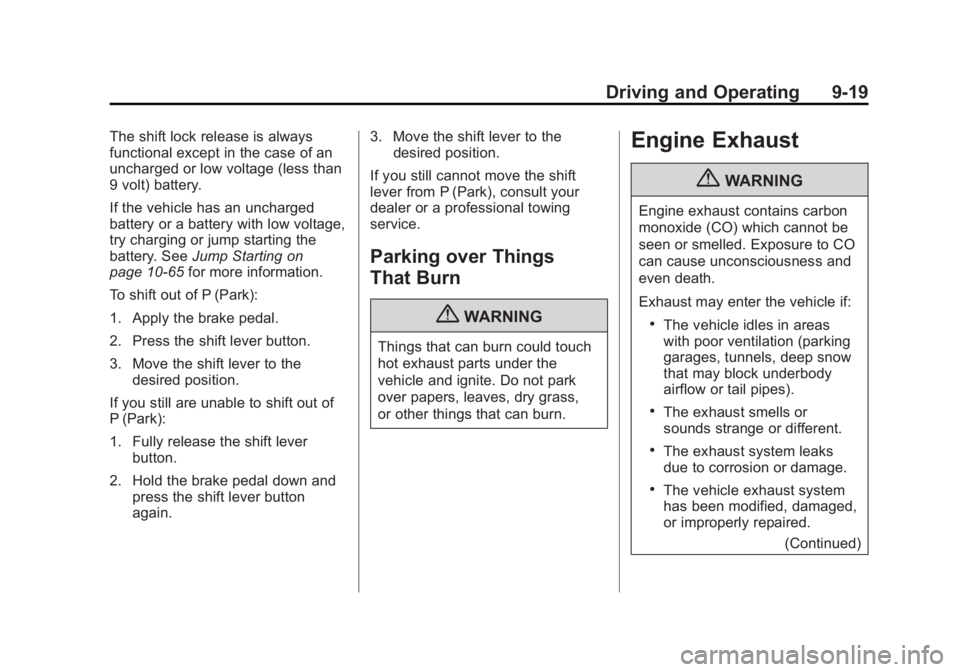
Black plate (19,1)Chevrolet Captiva Sport Owner Manual - 2013 - crc - 11/12/12
Driving and Operating 9-19The shift lock release is always
functional except in the case of an
uncharged or low voltage (less than
9 volt) battery.
If the vehicle has an uncharged
battery or a battery with low voltage,
try charging or jump starting the
battery. See Jump Starting on
page 10 ‑ 65 for more information.
To shift out of P (Park):
1. Apply the brake pedal.
2. Press the shift lever button.
3. Move the shift lever to the
desired position.
If you still are unable to shift out of
P (Park):
1. Fully release the shift lever
button.
2. Hold the brake pedal down and
press the shift lever button
again. 3. Move the shift lever to the
desired position.
If you still cannot move the shift
lever from P (Park), consult your
dealer or a professional towing
service.
Parking over Things
That Burn
{ WARNINGThings that can burn could touch
hot exhaust parts under the
vehicle and ignite. Do not park
over papers, leaves, dry grass,
or other things that can burn. Engine Exhaust
{ WARNINGEngine exhaust contains carbon
monoxide (CO) which cannot be
seen or smelled. Exposure to CO
can cause unconsciousness and
even death.
Exhaust may enter the vehicle if: .
The vehicle idles in areas
with poor ventilation (parking
garages, tunnels, deep snow
that may block underbody
airflow or tail pipes). .
The exhaust smells or
sounds strange or different. .
The exhaust system leaks
due to corrosion or damage. .
The vehicle exhaust system
has been modified, damaged,
or improperly repaired.
(Continued)
Page 208 of 374
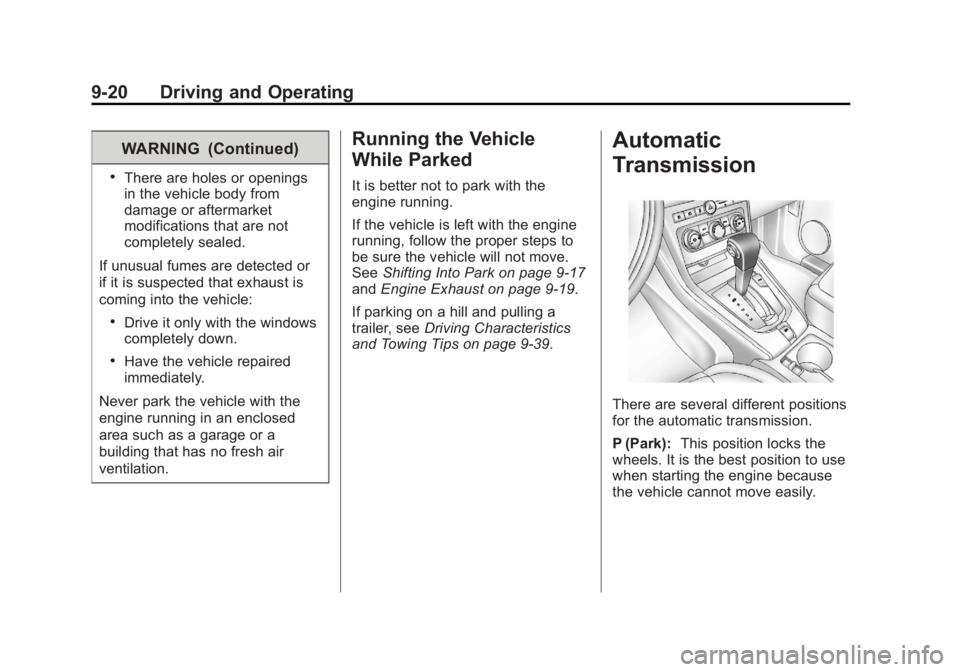
Black plate (20,1)Chevrolet Captiva Sport Owner Manual - 2013 - crc - 11/12/12
9-20 Driving and Operating WARNING (Continued) .
There are holes or openings
in the vehicle body from
damage or aftermarket
modifications that are not
completely sealed.
If unusual fumes are detected or
if it is suspected that exhaust is
coming into the vehicle: .
Drive it only with the windows
completely down. .
Have the vehicle repaired
immediately.
Never park the vehicle with the
engine running in an enclosed
area such as a garage or a
building that has no fresh air
ventilation. Running the Vehicle
While Parked It is better not to park with the
engine running.
If the vehicle is left with the engine
running, follow the proper steps to
be sure the vehicle will not move.
See Shifting Into Park on page 9 ‑ 17
and Engine Exhaust on page 9 ‑ 19 .
If parking on a hill and pulling a
trailer, see Driving Characteristics
and Towing Tips on page 9 ‑ 39 .Automatic
Transmission
There are several different positions
for the automatic transmission.
P (Park): This position locks the
wheels. It is the best position to use
when starting the engine because
the vehicle cannot move easily.
Page 209 of 374

Black plate (21,1)Chevrolet Captiva Sport Owner Manual - 2013 - crc - 11/12/12
Driving and Operating 9-21
{ WARNINGIt is dangerous to get out of the
vehicle if the shift lever is not fully
in P (Park) with the parking brake
firmly set. The vehicle can roll.
Do not leave the vehicle when the
engine is running. If you have left
the engine running, the vehicle
can move suddenly. You or others
could be injured. To be sure the
vehicle will not move, even when
you are on fairly level ground,
always set the parking brake and
move the shift lever to P (Park).
See Shifting Into Park on
page 9 ‑ 17 and Driving
Characteristics and Towing Tips
on page 9 ‑ 39 .
Make sure the shift lever is fully in
P (Park) before starting the engine.
The vehicle has an automatic
transmission shift lock control system. You have to fully apply the
regular brakes first and then press
the shift lever button before you can
shift from P (Park) when the ignition
key is in ON/RUN. If you cannot
shift out of P (Park), ease pressure
on the shift lever and push the shift
lever all the way into P (Park) as
you maintain brake application.
Then press the shift lever button
and move the shift lever into
another gear. See Shifting out of
Park on page 9 ‑ 18 .
R (Reverse): Use this gear to
back up.
Notice: Shifting to R (Reverse)
while the vehicle is moving
forward could damage the
transmission. The repairs would
not be covered by the vehicle
warranty. Shift to R (Reverse) only
after the vehicle is stopped.
To rock the vehicle back and forth to
get out of snow, ice, or sand without
damaging the transmission, see If
the Vehicle Is Stuck on page 9 ‑ 9 . N (Neutral): In this position, the
engine does not connect with the
wheels. To restart the engine when
the vehicle is already moving, use
N (Neutral) only. Also, use
N (Neutral) when the vehicle is
being towed.
{ WARNINGShifting into a drive gear while the
engine is running at high speed is
dangerous. Unless your foot is
firmly on the brake pedal, the
vehicle could move very rapidly.
You could lose control and hit
people or objects. Do not shift
into a drive gear while the engine
is running at high speed.
Notice: Shifting out of P (Park) or
N (Neutral) with the engine
running at high speed may
damage the transmission. The
repairs would not be covered by
the vehicle warranty. Be sure the
engine is not running at high
speed when shifting the vehicle.
Page 210 of 374
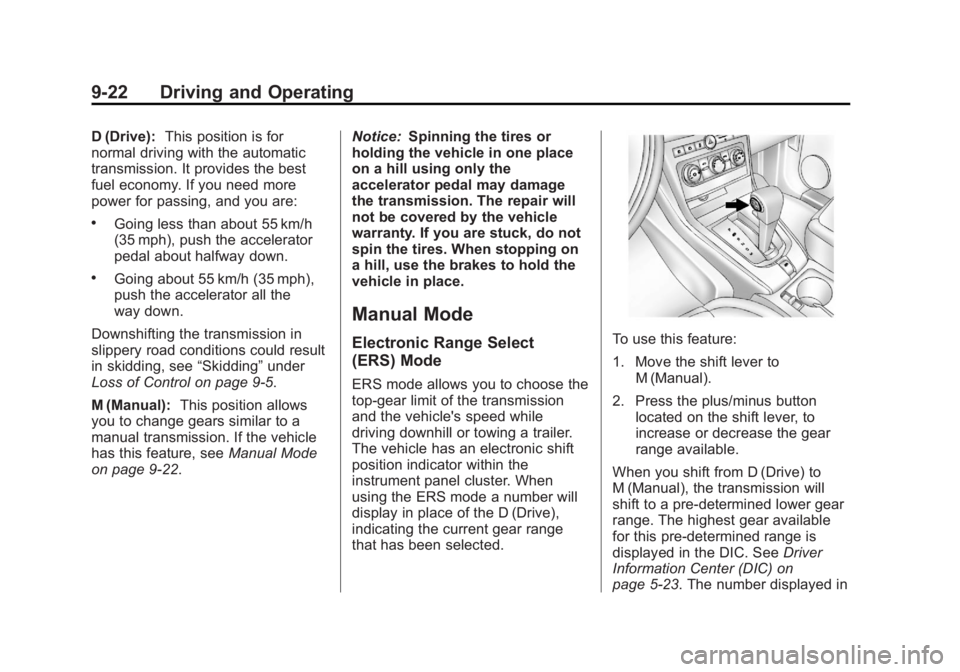
Black plate (22,1)Chevrolet Captiva Sport Owner Manual - 2013 - crc - 11/12/12
9-22 Driving and Operating D (Drive): This position is for
normal driving with the automatic
transmission. It provides the best
fuel economy. If you need more
power for passing, and you are: .
Going less than about 55 km/h
(35 mph), push the accelerator
pedal about halfway down. .
Going about 55 km/h (35 mph),
push the accelerator all the
way down.
Downshifting the transmission in
slippery road conditions could result
in skidding, see “ Skidding ” under
Loss of Control on page 9 ‑ 5 .
M (Manual): This position allows
you to change gears similar to a
manual transmission. If the vehicle
has this feature, see Manual Mode
on page 9 ‑ 22 . Notice: Spinning the tires or
holding the vehicle in one place
on a hill using only the
accelerator pedal may damage
the transmission. The repair will
not be covered by the vehicle
warranty. If you are stuck, do not
spin the tires. When stopping on
a hill, use the brakes to hold the
vehicle in place.
Manual Mode Electronic Range Select
(ERS) Mode ERS mode allows you to choose the
top-gear limit of the transmission
and the vehicle's speed while
driving downhill or towing a trailer.
The vehicle has an electronic shift
position indicator within the
instrument panel cluster. When
using the ERS mode a number will
display in place of the D (Drive),
indicating the current gear range
that has been selected. To use this feature:
1. Move the shift lever to
M (Manual).
2. Press the plus/minus button
located on the shift lever, to
increase or decrease the gear
range available.
When you shift from D (Drive) to
M (Manual), the transmission will
shift to a pre-determined lower gear
range. The highest gear available
for this pre-determined range is
displayed in the DIC. See Driver
Information Center (DIC) on
page 5 ‑ 23 . The number displayed in
Page 211 of 374

Black plate (23,1)Chevrolet Captiva Sport Owner Manual - 2013 - crc - 11/12/12
Driving and Operating 9-23the DIC is the highest gear that the
transmission will be allowed to
operate in. This means that all
gears below that number are
available. For example, when
4 (Fourth) is shown, 1 (First) through
4 (Fourth) gears are automatically
shifted by the vehicle. The
transmission will not shift into
5 (Fifth) until the + (Plus) button is
used or you shift back into D (Drive).
While in M (Manual), the
transmission will prevent shifting to
a lower gear range if the engine
speed is too high. You have a brief
period of time to slow the vehicle.
If vehicle speed is not reduced
within the time allowed, the lower
gear range shift will not be
completed. You must further slow
the vehicle, then press the − (Minus)
button to the desired lower gear
range.
Automatic Engine Grade Braking is
not available when the ERS is
active. It is available in D (Drive).
While using the ERS, cruise control
can be used. Fuel Economy Mode The vehicle may have a fuel
economy mode. When engaged,
fuel economy mode can improve the
vehicle's fuel economy.
Pressing the eco button by the shift
lever will engage fuel economy
mode. When activated, the eco light
in the instrument cluster will come
on. See Fuel Economy Light on
page 5 ‑ 20 . Pressing the button a
second time will turn fuel economy
mode off. When fuel economy mode is on: .
The transmission will upshift
sooner, and downshift later. .
The torque converter will lock –
up sooner, and stay on longer. .
The gas pedal will be less
sensitive. .
The vehicle ’ s driving
performance will be more
conservative. .
The vehicle's computers will
more aggressively shut off fuel
to the engine under deceleration. .
The engine idle speed will be
lower.
Do not use fuel economy mode
while towing.
Page 215 of 374
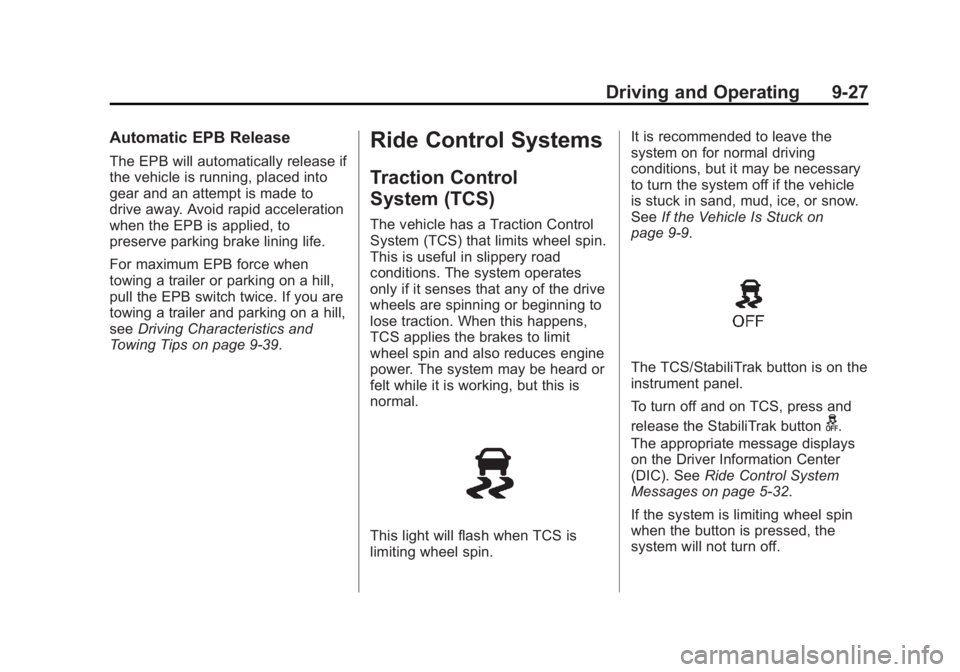
Black plate (27,1)Chevrolet Captiva Sport Owner Manual - 2013 - crc - 11/12/12
Driving and Operating 9-27Automatic EPB Release The EPB will automatically release if
the vehicle is running, placed into
gear and an attempt is made to
drive away. Avoid rapid acceleration
when the EPB is applied, to
preserve parking brake lining life.
For maximum EPB force when
towing a trailer or parking on a hill,
pull the EPB switch twice. If you are
towing a trailer and parking on a hill,
see Driving Characteristics and
Towing Tips on page 9 ‑ 39 .Ride Control Systems Traction Control
System (TCS) The vehicle has a Traction Control
System (TCS) that limits wheel spin.
This is useful in slippery road
conditions. The system operates
only if it senses that any of the drive
wheels are spinning or beginning to
lose traction. When this happens,
TCS applies the brakes to limit
wheel spin and also reduces engine
power. The system may be heard or
felt while it is working, but this is
normal.
This light will flash when TCS is
limiting wheel spin. It is recommended to leave the
system on for normal driving
conditions, but it may be necessary
to turn the system off if the vehicle
is stuck in sand, mud, ice, or snow.
See If the Vehicle Is Stuck on
page 9 ‑ 9 .
The TCS/StabiliTrak button is on the
instrument panel.
To turn off and on TCS, press and
release the StabiliTrak button
g .
The appropriate message displays
on the Driver Information Center
(DIC). See Ride Control System
Messages on page 5 ‑ 32 .
If the system is limiting wheel spin
when the button is pressed, the
system will not turn off.